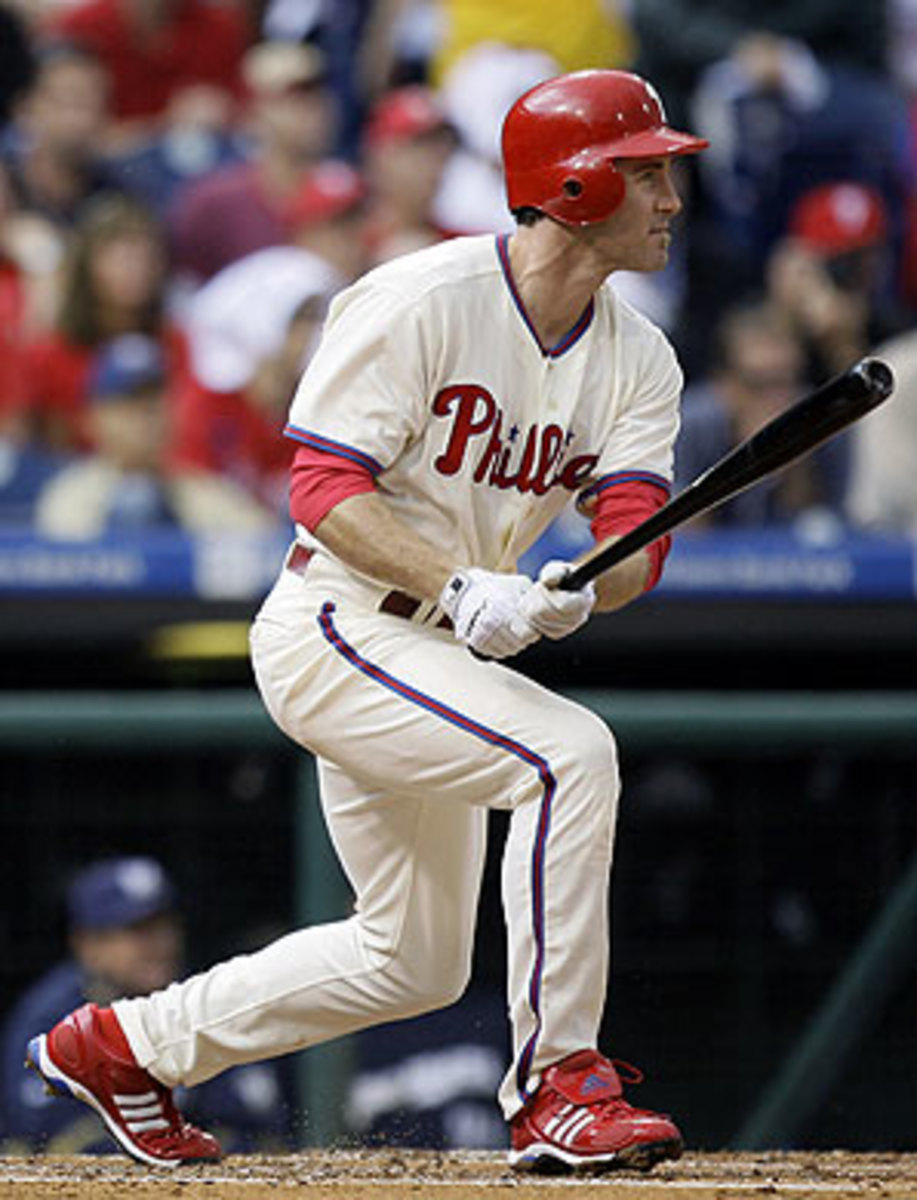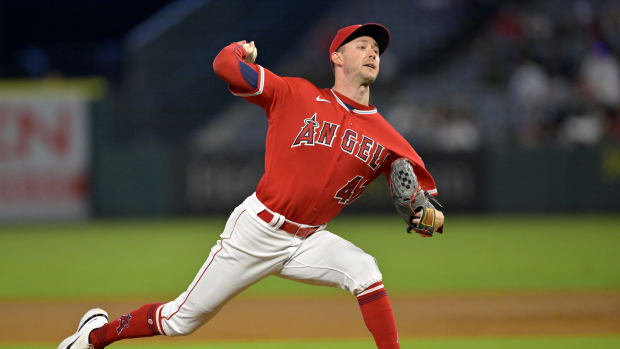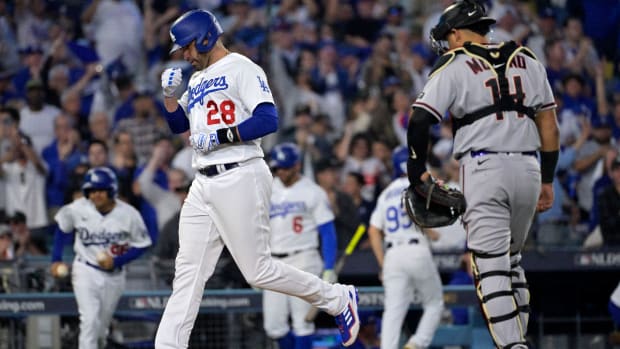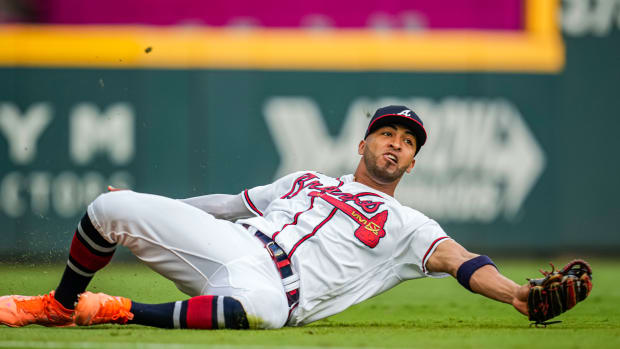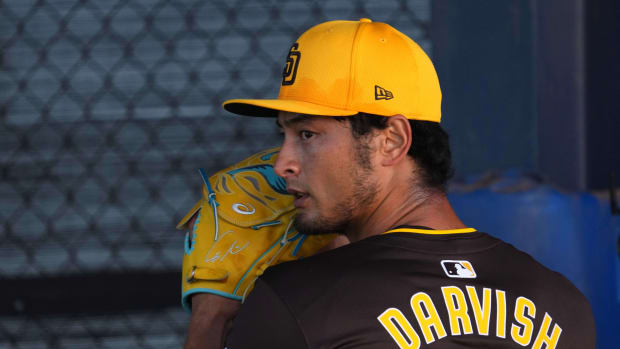NLCS Preview: Dodgers-Phillies
The Dodgers shocked just about everyone but themselves in sweeping the Cubs in the first round, outscoring the 97-win juggernaut by a combined tally of 20-6.
Adding color to what already appears to be a competitive series, the Phillies-Dodgers matchup is one steeped in LCS history. The two teams battled three times for the NL pennant from 1977 to '83, with the Dodgers taking the first two series in memorable and sometimes bizarre fashion, but the Phils got the last laugh in '83. More recently Phillies center-fielder Shane Victorino was astutely plucked from the Dodgers' system via the Rule 5 Draft in 2004, and right-fielder Jayson Werth spent three years in L.A. before landing in Philadelphia. Finally, we'd be remiss if we didn't note nearby Norristown, Pa., native (and Phillies' free-agent signee circa 1945) Tommy Lasorda's long-standing grudge against the Phillie Phanatic.
It's no secret the Phillies are first and foremost a slugging team as far as their offense is concerned. They led the National League in home runs (214), with seven players reaching double digits and three more finishing with nine. Furthermore, they placed a close second in the NL in their percentage of runs generated via homers (42.6 percent). That trait was on display in the Division Series against the Brewers, as the Phils plated two-thirds of their 15 runs via five homers. Victorino's grand slam off of CC Sabathia fueled their Game 2 victory, while four blasts, including a pair by Burrell, provided all six of their runs in the Game 4 clincher.
On the other hand it's worth noting that in the first round the Phillies struggled to score when they didn't get the long ball, managing just four runs in their two homerless games and putting up runs in only six of the series' 36 innings. That's not entirely out of character; the Phillies were held homerless in fewer games than all but two NL clubs, but when they failed to go deep they scored just 2.9 runs per game, 12th in the league under such circumstances. Nonetheless, their arsenal does include smart baserunning, a trait due in part to the influence of Lopes, one of the great percentage basestealers of all time. These Phillies were successful on 84.5 percent of their stolen base attempts, a clip topped only by last year's club among all teams since 1954. Rollins (47 out of 50), Werth (20 out of 21) and Utley (14 out of 16) were successful even more frequently, and Victorino (36 out of 47) was the only Phillie gunned down more than three times. Additionally, the team placed second in the league in Equivalent Baserunning Runs, with Rollins, Victorino and Werth all ranking among the majors' top 15.
The major nit to pick with regard to skipper Charlie Manuel's post-season lineup card might be the decision to bat Utley and Howard back-to-back. The former doesn't lose much when facing southpaws (.277/.368/.519 this year, compared to .301/.387/.545 versus righties), but why leave an opposing manager the opportunity for an incremental gain when Howard's much larger split (.224/.294/.451 against southpaws this year, compared to .268/.366/.601 versus righties) will generally prompt a move anyway? Then again, splitting the two with Werth, Victorino or Burrell -- all of whom enjoy much more favorable platoon advantages against lefties than Utley does against righties -- would make it an easy call for an opposing skipper to keep his powder dry until Howard's at-bat. In the grand scheme Manuel's probably making the right call.
Neither of those two lefty hitters did much damage during the opening series; they combined to go 4-for-26 with a pair of doubles and seven walks, five of them Howard's, two of those intentional. In addition to the aforementioned homers by Victorino and Burrell (whose Game 4 performance allayed concerns about his pre-series lower back woes), the Phils got strong contributions from Rollins and Werth. Although Werth hacked his way through a three-strikeout opener, he collected five extra-base hits in the remaining games, including three off of righties, underscoring the fact that he's now a valuable every day player in this lineup.
As for the Dodgers, the return of Furcal allowed them to field a stronger lineup in the Division Series than at any point prior to clinching the NL West flag. The shortstop had put up MVP-caliber numbers back in April before being sidelined due to a herniated disc that required surgery. Returning to the leadoff spot for the LDS, he got on base seven times in 15 plate appearances, and while he didn't steal a base, he demonstrated his speed -- not to mention his creativity -- by beating out a two-out bunt in Game 2, driving in a run that helped turn a trickling one-run inning into a five-run flood. Later in the series he would underscore his improved health by scoring from second on a single, scoring from first on a double, advancing to second on a throw home after singling and helping generate an error on a pickoff play. The Dodgers are a completely different team with him atop the lineup, with a 22-16 record including the LDS.
That improvement compounds the one provided by Ramirez, who hit a torrid .396/.489/.743 with 17 homers and 53 RBIs in 53 games after being acquired from the Red Sox. Prior to his arrival the Dodgers offense was woefully underpowered, ranking second to last in the league in both home runs and percentage of runs generated via homers. With him, it was a different story:
Of course the above splits are due to more than just Ramirez's dreadlocked presence. The acquisition of Blake to shore up the team's quagmire at third base and the solidification of full-time roles for Kemp and Ethier at the expense of Andruw Jones and Juan Pierre contributed greatly to the late-season offense's strength. Ethier hit a searing .368/.448/.649 over the final two months, a performance that likely had no more to do with any mythical protection effect than it did with his enjoying some newfound certainty about his role.
Ethier had a quiet Division Series, but Martin snapped out of a second-half funk (.336 SLG) with three doubles and a homer and Loney had the go-ahead hits in the first and third games via a grand slam off of Ryan Dempster and a two-run double off of Rich Harden. Ramirez was in form, going 5 for 10 with a pair of homers, including a golf shot off Sean Marshall in Game 1 that had TBS analyst Tony Gwynn agape. He now has a record 26 post-season homers in his career, and every time he rises to the occasion his legend grows. He's this generation's Reggie Jackson, complete with extra mustard.
Given that the Dodgers will face two lefties in the first three games in Hamels and Jamie Moyer, it's worth noting that they were much stronger against southpaws (.275/.350/.419, finishing in a virtual tie for second in the league in OBP) than righties (.260/.326/.390). Neither Loney (.249/.303/.361) nor Ethier (.243/.325/.368) fared well against lefties, though both showed much wider splits this year than over the course of their careers. Such indicators might prompt Torre to insert Nomar Garciaparra (.339/.424/.643) and/or Pierre (.346/.388/.383) into the lineup if he wants to shake things up, particularly if Hamels dominates the lefty hitters in Game 1.
The Dodgers didn't attempt a steal in the first round, but they ranked fourth in the league in steals (126) and fifth in stolen base percentage (74.6 percent). Furcal (8 for 11 this year, 62 for 81 in 2005-06) may be itching to continue showcasing his health by returning this weapon to his arsenal. Kemp (35 for 46) might be on the go to give a shot at scoring a run with the lower third of the order, and Martin (18 for 24) has great speed for a catcher. Pierre (40 for 52) likely won't get too many chances coming off the bench, but if he miraculously winds up on base, bet on him to go.
The Phillies' bench drew just nine plate appearances in the four games of the LDS. Manuel bypassed Coste for the start in Game 2 despite the fact that he'd been behind the dish for 22 of Myers' previous 24 starts; the following off-day made resting Ruiz a moot point, and could drive a repeat of that decision. Manuel pulled off a few late-inning double switches to upgrade over Burrell in left field, calling upon Bruntlett instead of his other outfielders in three of the four games, something he had experimented with late in the year.
Manuel's biggest move with regards to his bench came in Game 4, when he started Dobbs, a stronger hitter but weaker-fielding third baseman than Feliz, with Joe Blanton on the mound. Manuel had resisted starting Dobbs in Game 2 behind Myers -- something he'd done in 14 of Ol' Punchyface's 30 starts --because they were facing the left-handed Sabathia. With the Dodgers considering lefty Clayton Kershaw for the Game 4 start against Blanton, Dobbs' playing time might again be curtailed, but Manuel is sure to find him pinch-hitting opportunities. Given the lefty-heavy tilt of the Phillies' bench, it's worth noting that Torre could use lefty Hong-Chih Kuo (who was deemed healthy enough to make L.A.'s roster) to neutralize the threat of a Dobbs or a Stairs in the late innings while still having lefty Joe Beimel on hand to face Utley and Howard.
Torre had even less occasion to use his bench against the Cubs than Manuel did against the Brewers, finding them just three plate appearances in the three games. At the moment he's got an odd collection of ex-famous people at his disposal. Kent would be starting at second base were it not for fact that he's still recovering from early-September surgery to repair a torn medial meniscus; as it is he's probably limited to pinch-hitting detail. Garciaparra probably represents the team's best power threat coming off the bench; he could also find his way into the lineup against one of the lefties for a spot start at first base if the Dodgers struggle against Hamels in Game 1. Pierre represents the team's best set of extra wheels for pinch-running purposes and their only true extra outfielder, though he's really not much of an upgrade over Ramirez in left or Kemp in center to offset the loss of either of those big bats in anything but a blowout.
As for the rest, Ozuna's got speed in his favor as well as a bit of outfield experience, though it's quite possible if such a calamity arose where the latter mattered, he'd play at third base and Blake would move to the outfield. Ardoin is merely an insurance policy. Berroa... well, he looks kind of bad-ass with that goatee, but he can't hit his hat size. If he's playing that means Furcal isn't, which spells serious trouble for the Dodgers.
Both teams got very strong performances from their rotations in the first round. Continuing to build on the ace form that saw him finish sixth in the league in both ERA and strikeouts and sixth in the majors in SNLVAR, Hamels dominated in Game 1. He struck out nine Brewers (eight of them swinging) largely with his devastating changeup, retired the first 14 hitters he faced and surrendered just two hits in eight innings overall. He'll look to do the same against the Dodgers in the opener, and again in Game 5 if necessary, since Manuel made it clear that he's not about to send Hamels back out on three days' rest to pull off a 1-4-7 trifecta.
Myers allowed only two hits against the Brewers, an effort that was largely overshadowed by his own tenacious at-bats against Sabathia. In any case he quelled whatever doubts lingered regarding his final two starts, looking much more like the pitcher who put up a 1.80 ERA over an 11-start stretch from late July to mid-September. Moyer was the weak link in the series against the Brewers, laboring through 90 pitches over four innings before being lifted for a pinch-hitter, but he came into the series on something of a roll as well, having put up a 3.39 ERA while allowing just 0.7 HR/9 since the All-Star break. As you might expect from a fly-ball pitcher who calls a homer-conducive park home, he pitched better in road games (2.92 ERA, 0.8 HR/9) than at Citizens Bank Ballpark (4.61 ERA, 1.1 HR/9), though to be fair this was the first time in his two-plus years with the Phillies that that was the case. Blanton was thought to be the weak link in the Phils' rotation but pitched a strong game in closing out the Brewers, striking out seven (five swinging), which rates as a surprise given his reputation as a pitcher who doesn't generate many strikeouts (5.1 per nine this year) or even swings-and-misses (11 percent, according to the data at Baseball-Reference.com, well below the major league average of 15 percent).
The Dodgers had no shortage of ace-like performances in their series. Lowe came in having put up a 1.27 ERA over his previous 10 starts (nine of them quality, the other a post-clincher tune-up). Riding his sinker/slider combo, he scattered seven hits over six innings, and despite allowing at least one baserunner in each frame he seemed able to conjure up ground balls and strikeouts exactly when needed. He does an equally good job of holding lefties and righties in check and is very good at avoiding the long ball (his 0.6 HR/9 was seventh among NL qualifiers, while Billingsley and Kuroda were ninth and 10th). Additionally his sinker-oriented approach is well-suited to working on short rest, and he has experience doing so. With the schedule for the LCS he could start Game 4 on three days' rest and then Game 7 on normal rest.
Billingsley, who ranked fifth in the NL in strikeouts, seventh in ERA and 10th in SNLVAR (or 16th in the majors in the latter category if you prefer to include Sabathia and Harden), was dominant in his start against the Cubs. He shut them out for six innings and whiffed seven before faltering in the seventh, by which point he had a 7-0 lead. Of the Dodgers' big three he's the most vulnerable to lefties (.274/.369/.391 this year), though some of that has to do with the .345 BABIP they managed against him. Kuroda came into the playoffs riding an 11-start streak during which he put up a 2.57 ERA, and delivered the knockout blow to the Cubs, generating ground balls galore (15 in 6 1/3 innings) while shutting them out into the seventh. At his best he's virtually unhittable; three times this year he took no-hitters into the fifth or later, including once against the Phillies on Aug. 24. In 13 innings against the Phillies he allowed just four hits and two runs.
Who the Dodgers start in Game 4 may be the biggest decision Torre makes in the series. His options besides Lowe are the 42-year-old Maddux and the 20-year-old Kershaw, the salty veteran righty bound for the Hall of Fame and the rookie southpaw still learning the ropes at the major league level. Maddux pitched at about a league-average level with the Padres but was rocked for a 5.09 ERA after being reacquired in late August (including a seven-run drubbing by the Phillies in his return); at this stage of his career he's got control, experience, guile, veteran herbs and spices, and plenty of moxie, but little in the way of stuff. Kershaw pitched much better after returning from a stint in the minors than he had before, putting up a 3.74 ERA with 65 strikeouts in 65 innings over his last 12 starts. He may be more vulnerable against a Phillies lineup that thumped southpaws to a .257/.337/.464 tune (compared to .255/.330/.426 against righties). While Torre has said the Dodgers need "a left-handed presence" against the Phillies, it's tough to imagine him giving Kershaw the ball if the Dodgers are down 2-1.
The Phillies came into the playoffs with the NL's best bullpen by several measures. They had the lowest ERA of any unit in the league (3.22) and led the NL in WXRL by almost three and a half wins, thanks in large part to Lidge's MLB-leading total. Lidge converted all 41 of his save opportunities, and prior to yielding a run on Sept. 27 had been scored upon just twice in his previous 28 outings over a two-month span. His Division Series performance showed that he's not bulletproof, however. In the opener Lidge labored for 35 pitches, struggling to control his slider, allowing as many baserunners in one inning as Hamels had in the previous eight, squandering the shutout and letting the tying run get into scoring position before striking out the game's final hitter. As BP's Joe Sheehan pointed out, he was a bit "homer lucky" in that he allowed just two this year despite a fly-ball rate that was basically unchanged from years past. He's more vulnerable than his record might otherwise indicate; cue the Albert Pujols 2005 NLCS footage, please.
The set-up men ahead of Lidge were similarly effective in the LDS, but not untouchable. Madson demonstrated his mid-90s heat and terrific changeup while showing his ability to go multiple innings in the finale; he can eat more than three outs if Manuel so desires. Romero held lefties to an anemic .102/.193/.153 but was pounded by righties at a .282/.444/.455 clip; he retired Prince Fielder in his one opportunity. In this series he'll likely come in to face Ethier and Loney if Torre keeps them together in the lineup; moving Kemp (.369/.417/.571 against lefties) up a notch in the batting order could thwart that plan, and in his pinstriped past Torre has shown a tendency to be mindful of such opportunities. Eyre's the lower-leverage lefty to give the Phils an opportunity to try such a dance twice, but he's miscast if Manuel decides to keep him in against righties, as he did in Game 3 against the Brewers. Durbin, the seventh-inning man, ranked among the best in the league at inducing double plays, and as his bases-loaded strikeout of Ryan Braun showed, he can miss bats to work his way out of a jam, too. Condrey and Happ are for lower-leverage situations, and the Phils decided against replacing the latter with former Dodger Rudy Seanez.
The Dodger bullpen finished second in the league in ERA (3.34) and fourth in WXRL, but as the Division Series showed, the pecking order there is more fluid. Takashi Saito, who missed two months this summer with a partially-torn ulnar collateral ligament and failed to retire a batter in his LDS Game 2 appearance, was left off the LCS roster. Broxton became the closer in Saito's absence, and while he's had a couple rocky stretches this year he is The Man now. The Cubs couldn't catch up to the combination of his high-90s heat and sharp slider in his three appearances, including a four-out save in the finale that had to boost the confidence of both the 24-year-old behemoth and his manager.
Ahead of Broxton, Wade has stepped into the go-to role. The rare rookie who has gained Torre's confidence, he's a command-and-control guy with an excellent curve and the ability to navigate with men on base; he led the league in the frequency with which he generated double plays when necessary despite being a decidedly fly ball-oriented pitcher. The lefty Beimel served more as a situational specialist this year than in the previous two under Grady Little, who used him for full innings in a Mike Stanton mode toward which Torre could have been expected to gravitate. Surprisingly Torre reined Beimel in a bit, and the percentage of lefties he faced rose from 37 percent in 2006-07 to 47 percent this year; he held them to a .232/.274/.304 line, compared to .263/.363/.337 against righties. He'll face Utley and Howard in some big spots. Park turned in a reasonably effective season in a swingman/middle relief role after wandering in the wilderness for most of the millennium, but he was knocked around over the final two months when used more heavily. McDonald has thrown just six major league innings but has a 3.26 ERA and 141 Ks in 141 minor league innings, mostly with Double-A Jacksonville.
The key question is whether Kuo has recovered enough from the bout of triceps soreness that kept him off the first-round roster. His high strikeout rate (10.8 per nine), ability to shut down both righties (.205/.284/.285 this year) and lefties (.202/.216/.340), and multi-inning capability are tantalizing. If he's effective, that may push Kershaw toward the Game 4 start.
The Phillies' defense ranked fifth in the league in raw Defensive Efficiency, fourth in PADE at 0.59 percent above average, but just ninth in Fielding Runs Above Average at -4. According to FRAA, Howard (-14) and the frequently-replaced Burrell (-11) stand out as liabilities. Everywhere else the team rates as average or better, with Werth (+9, spread across all three outfield spots) rating the highest; during the LDS Werth demonstrated his rifle arm by gunning down Corey Hart as he took a wide turn at first base in Game 3, ending a threat. Turning to The Fielding Bible's observation-based Plus/Minus system, Utley and Rollins top their respective positions, and Victorino ranks among the top 10 center-fielders. Behind the plate Ruiz (23.5 percent of runners caught) isn't particularly effective at curtailing the running game (neither is Coste at 22.8 percent caught). The Brewers never even got a chance to attempt a steal, rendering that point moot, but while the Dodgers didn't steal against the Cubs either, they didn't lack for base-stealers and figure to run if the situation dictates.
Overall the Dodgers defense fares better according to FRAA (+1, seventh in the league) than either raw Defensive Efficiency (10th at .691) or PADE (ninth at -0.49 percent). Either way those numbers need to be taken with a grain of salt given Furcal's absence; he was at -2 FRAA this year but +27 over the previous two years, and his presence represents a serious upgrade over Berroa or Garciaparra and a significantly improved defensive unit. DeWitt vs. Kent is more of a wash: As a third baseman DeWitt was well above average according to both FRAA and Plus/Minus, and he was the only Dodger to crack a positional top 10 thanks to his handling of bunts. As a second baseman in more limited duty he was well below average, more mobile than the statuesque Kent but a still a work in progress.
The outfield is another story. After four months of bungling the situation by giving too much time to Pierre and Jones at the expense of Ethier, Torre stumbled onto a solution prompted by Ramirez's arrival. Kemp isn't the second coming of Devon White in center, but after Little operated as though a restraining order were preventing him from playing Kemp in the middle pasture, Torre's willingness to go that route marked a turning point for the Dodgers. Both the FRAA numbers (+6) and Plus/Minus (+1) may be overestimating Kemp a tad thanks to the proximity of Ramirez, but he can get the job done well enough to keep Pierre out of everyone's hair, and that's best for the Dodgers' chances.
As noted in my preview of the first-round series, Manuel won't draw comparisons to Tony La Russa for tactical acumen or Lou Piniella for his dramatic flair, but he showed creativity in cobbling together an unorthodox third-base platoon and flexibility in letting Werth take over right field on a full-time basis after Jenkins went down with a hip injury in August. After being criticized for his handling of the bullpen in the past, he's drawn acclaim for that this year, but that's more a product of Lidge's success and the quality of his personnel in general relative to years' past. His low-pressure style appears to have put the Phillies at ease as the camera has drawn near for the close-up, and that's worth something.
One of the interesting angles to this series is the link between Manuel and Ramirez, whom he managed both in Triple-A in 1993 and in Cleveland in 2000, serving as the Tribe's hitting coach in between. Given Ramirez's .212 average and one homer in 40 PA against the Phillies this year, the skipper may have some insight into how to handle his protegé -- or not. As with all things Manny that involve a bat in hand, that's a show worth paying to see.
Much to Hank Steinbrenner's chagrin, Torre earned some amount of vindication for winning a division title out west after his unseemly exit from the Bronx. Derided for the Dodgers' lower-than-expected 84 wins, he did navigate around a roster that lost 1,377 days and a MLB-high 43 percent of its payroll to the disabled list, and if he botched the third base and outfield logjams initially, he did bite the bullet and put Kemp in center field in order to field his most potent lineup once Ramirez arrived. Torre has thus far stayed out of the dreadlocked slugger's way and let Manny be Manny, both on the field and in the clubhouse, and there's no question that the Dodgers' best stretch of baseball has coincided with a looseness that stands in stark contrast to last year's late-season drama regarding Kent and the since-departed Luis Gonzalez. (Compare Kemp absorbing the brunt of Kent's attack with his inability to keep a straight face after watching one of Manny's basket catches.)
Torre has also shown flexibility with regard to his lineup's late-September returns (yes on Furcal, no on Kent) and his bullpen, incorporating Wade despite his general reservations about rookies, finding productive roles for the oft-injured Kuo and the long-ineffective Park, and tabbing Broxton over Saito. Clearly the lessons of his Yankee tenure have not been lost; while Broxton's no Mariano Rivera, six of his 15 saves (including the one in the clincher) involved more than three outs. The man has managed more post-season games than any skipper in history (126 and counting) and is well acquainted with the way the game changes in October. That has to count as a plus here.
Despite the difference in full-season records, this is a relatively even matchup. Hamels is possibly the best starter on either team, but the Phillies' reluctance to bring him back on three days' rest may neutralize that if the Dodgers shorten their rotation and opt for Lowe to start Game 4. If that's the case Philadelphia's only clear advantage in the matchups would come in the opener, whereas a Hamels/Billingsley Game 5 could be a tossup (note that the extra day off between Games 4 and 5 will keep the latter on normal rest), and Lowe-Blanton or Lowe-Moyer might be expected to lean the Dodgers' way, tilting the series as well.
Otherwise Torre has one decision that may put him on the spot (Maddux/Kershaw for Game 4), something he generally tries to avoid. Either way that Game 4 pairing could still favor the Dodgers by a hair, but the rest are tossups, with Hamels' and Billingsley's advantages over their opponents canceling out. What it may come down to in that case are the Dodgers staff's stinginess in surrendering home runs (they led the NL with the fewest allowed at 123 -- 24 fewer than any other club) and their tactical advantage in being able to counter the Phillies' concentration of lefty threats with one pitcher, as compared to the Dodgers' more dispersed lineup.
In the end, I'm willing to go out on a limb and call this for the Dodgers in six.






























